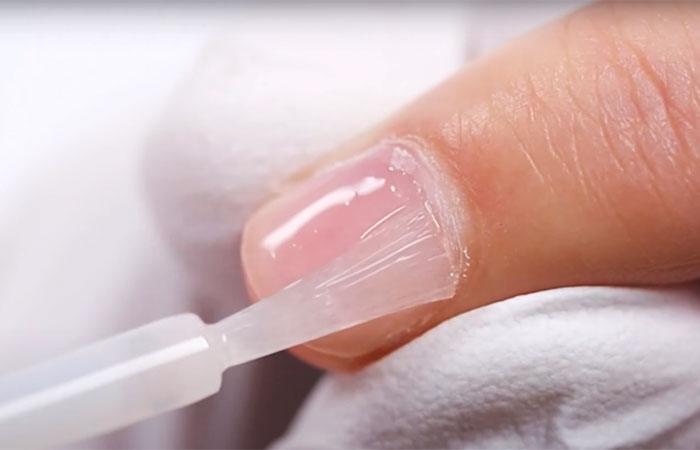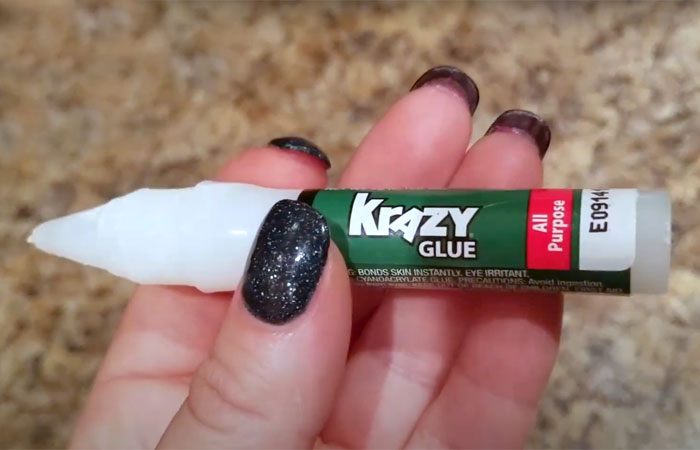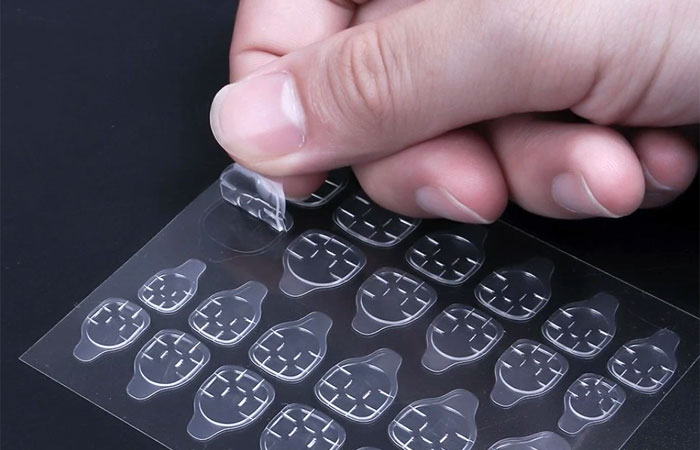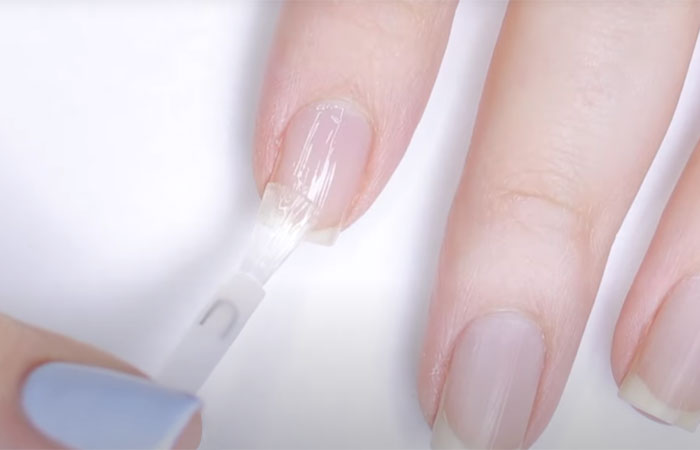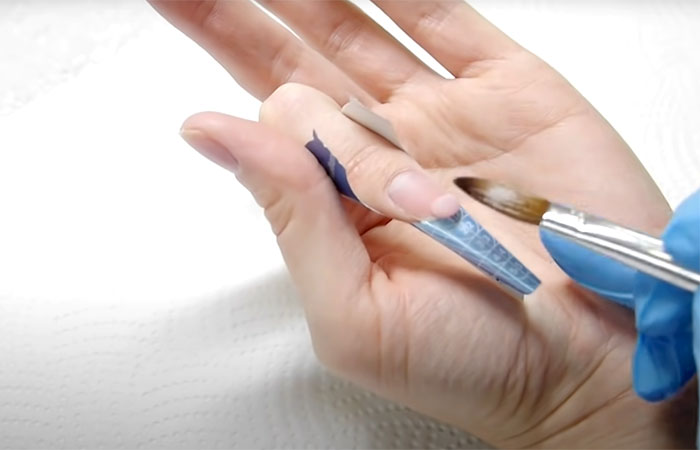When your press-on nail pops off at work before a big meeting, it may be tempting to reach for the tube of super glue in your desk drawer to stick it back on. However, that will likely do more harm than good.
When it comes to glue and other adhesives, they are not all interchangeable. So, what are you to do when an impromptu event comes up leaving zero time for a professional manicure and your nail glue bottle is empty?
Before you decide that using super glue to put on your acrylic nails just this one time will be ok, read on and find out why it isn’t a good choice and what you can use instead.
Table of Contents
Is Nail Glue the Same as Super Glue?
Though nail glue and super glue are very similar, they are not exactly the same thing. The main adhesive ingredient, cyanoacrylate, is the same in both nail glue and super glue.
In both types of glue, this ingredient bonds quickly to whatever surface it is used on as the monomers polymerize forming a long, strong chain that holds the two surfaces together.
What differs is concentration. Standard superglue is 100% cyanoacrylate, whereas nail glue has other ingredients.
Can Super Glue Be Used For Fake Nails?
The short answer is no. A quick internet search will show that some people have used it with success, but that doesn’t mean it was a good idea.
Cyanoacrylate is a very strong adhesive, with one type of cyanoacrylate glue even breaking a Guinness World Record when it successfully lifted a car that weighed over 5 tons with only 9 drops of glue.
With that level of strength, it may seem like the perfect long-lasting solution, but the other ingredients in nail glue serve an important purpose. While cyanoacrylate is very strong, its bond weakens when exposed to water.
Nail glue adds ingredients that help it last longer through handwashing and showers. Super glue’s strong bond also makes it very rigid, and nail glue contains ingredients that help the glue bond to the nail while remaining somewhat flexible.
What Can Happen If You Use Super Glue?
If you use super glue, it can cause issues for the skin and nail bed. While any nail glue can cause irritation for people with extremely sensitive skin, the concentration in super glue can cause irritation even if nail glues don’t.
In addition to causing dermatitis on the skin around the nails, it can also trap moisture and cause a fungal infection before that moisture weakens its bond.
Also, anything that can lift up a 5-ton car is going to cause some serious damage when it comes time to remove the nails or if one accidentally pops off. It will undoubtedly remove several layers of the nail with it, leaving it weak and prone to breaking or splitting.
To remove super glue from nails, you will have to soak your nails in either nail polish remover with acetone, pure acetone, or rubbing alcohol to weaken the glue’s bond so you can gently separate the fake nails from the natural nail. This can take a long time and will make your skin dry as well as dehydrate your nails which can make them brittle and prone to breakage.
Before you open your toolbox to search for other glue that you can use, it is important to know that other commonly used glues besides super glue won’t work either. Krazy Glue is the same as super glue, Gorilla Glue is a polyurethane glue that is very damaging to nails and skin, and many other types of glue take too long to adhere in addition to being possible irritants.
What Can Be Used Instead of Nail Glue?
1. Sticky Nail Tabs
Sticky nail tabs (like these) are used to come with press-on nails and can easily be bought online. They are the least damaging option, even being less damaging than nail glue.
The one drawback is they are less durable than the other options. If you have a tendency to use your hands a lot, they won’t last long. This makes them a great choice for a one-time event like a party, wedding, or holiday.
Sticky nail tabs are easy to apply and cause little to no damage when removed, making them perfect for the short term.
How to Apply
- Wash the nails clean with soap and water, and prep each nail with a swipe of alcohol or acetone to remove any natural oils.
- Apply the tabs to your natural nail so you can make sure they fit properly without overlapping on the skin around the nail.
- Apply the fake nail on the top of the tab and hold for 20 to 30 seconds to allow it to adhere.
To remove the nail tabs, simply soak nails in warm, soapy water for 1 to 2 minutes and gently remove nails. Use oil to remove any sticky residue that’s left.
See Also: How to Remove Nail Polish Without Acetone
2. Gel Nail Polish Base Coat
In a gel manicure, the base coat (example) provides a sticky layer for the gel color to grab onto. It can do the same thing for fake nails as well. This can be a great alternative for those who have had an allergic reaction to nail glue but can handle gel polish manicures and want to add length.
How to Apply
- Wash hands in soap and water and prep nails with alcohol or acetone to remove any natural oils.
- Apply a layer of the gel base coat and cure under the UV light for 30 seconds.
- While it cures, you will need to press the fake nail onto the natural nail the whole time. This ensures that the entire surface of the natural nail bonds to the fake nail and doesn’t leave gaps where it can be popped off.
- Once all the nails are on, you can apply the base coat over the fake nail, and after it is cured follow with the top coat and cure again to give the nails a professional finish.
The nails can be removed in the same way regular gel manicures are removed.
Related: Acrylic vs Gel vs SNS Nails
3. Acrylic Liquid and Acrylic Powder
The mixture of an acrylic liquid monomer and powder that professionals use at LA Nails, Dashing Diva, and other salons can be used to glue nails on too. This is another good choice for people who have experienced an allergic reaction to nail glue.
How to Apply
- Wash hands and prep the nails with alcohol or acetone to remove any natural oil.
- Lightly dip your acrylic nail brush into the liquid and gently tap off the excess.
- Dip it into the acrylic powder to make a small bead of acrylic.
- Put the bead of acrylic in the center of your natural nail and press the fake nail onto it gently, making sure it adheres to the entire nail.
- Hold down for 10-20 seconds to allow it to dry. Make sure that the bead is small so no excess squeezes out the sides as you press the nail down.
The nails can be removed in the same way regular acrylic nails are removed.
See Also: How to Thin Out Goopy Nail Polish
The Bottom Line
When it comes to products to use on your skin and nails, as tempting as it might be to reach for cheap alternatives, it is important to remember that they are formulated with those delicate areas in mind.
If something is strong enough to hold up a car, it’s probably too strong for something delicate enough to break bumping it too hard on a drawer like your nails.
With the three alternatives we discussed, as well as the many different brands of nail glue available, there are a lot of options available to help you get amazing fake nails without reaching for the super glue.

